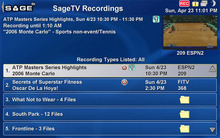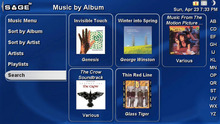PVR stack, Gentoo Linux convert PC to PVR
Apr 25, 2006 — by LinuxDevices Staff — from the LinuxDevices Archive — 6 views SageTV is distributing its personal video recording (PVR) software on a Gentoo Linux installation CD. The company previously sold a Windows-based version of its Media Center software, while offering its Linux version only to OEMs (original equipment manufacturers). Additionally, the company is shipping a “place-shifting” add-on for both versions.
SageTV is distributing its personal video recording (PVR) software on a Gentoo Linux installation CD. The company previously sold a Windows-based version of its Media Center software, while offering its Linux version only to OEMs (original equipment manufacturers). Additionally, the company is shipping a “place-shifting” add-on for both versions.
SageTV says its new Gentoo Linux distribution will let users “Enjoy the SageTV PVR, music, and photos experience with the always-on reliability of Linux, with much more effective virus and spyware protection.”
SageTV's Media Center software allows users to record and playback music or, in conjunction with a TV tuner/capture card, video. A “10-foot” interface with remote control support allows users to record shows singly or by the season, using an included 14-day EPG (electronic program guide) for Canada and the U.S. Users can pause, rewind, and fast-forward live or recorded cable, satellite, or antenna TV, and record multiple shows on multiple tuners simultaneously, the company says.


Media Center v5 screenshots
(Click either image to enlarge)
SageTV's Gentoo distribution
SageTV's Media Center for Linux product is based on Gentoo Linux, and uses a modified version of the Gentoo installation CD. While potentially confusing for Linux newbies, installing the product appears to be relatively straightforward, gauging from SageTV's online instructions.
The software is distributed as an ISO image, which users must burn to a CD. Next, they must configure their AMD- or Intel-based PC to boot from its CD drive, and execute half a dozen shell scripts, by typing in commands such as “/mnt/cdrom/defboot.sh /dev/hda1” from a command line prompt.
The Media Center installation completely reformats the drive on which it is installed. Three installation “modes” are provided, including:
- Mode 0 — a headless server installation for systems without monitors
- Mode 1 — provides an interface but no playback (experimental)
- Mode 2 — installs both server and user interface/playback client. This requires a recent NVIDIA graphic chip, as well as a supported sound chip
Optional place-shifting add-on
Additionally, SageTV is shipping a “place-shifting” add-on that works with version 5 of its Media Center software, for either Linux or Windows. The version available with Gentoo Linux appears to be version 4, however, suggesting that for now at least, placeshifting functionality may be limited to Linux device OEMs and Windows PC users.
The Placeshifter add-on lets users control a Media Center-equipped PC or device at home or, within the up-stream speed limitations of their home broadband connection, away from home. This capability could interest users of Internet- and multimedia-enabled phones; market research firm ABI forecast earlier this week that “converged mobile and home networks” could prove disruptive to mobile phone carriers, allowing users to bypass carrier content offerings, and directly access their home-based premium media content.
CEO Mike Machado stated, “Combining PVR and placeshifting capabilities solves the performance, complexity, and cost problems created by standalone placeshifting solutions. You don't need an extra piece of hardware on your network, you don't need to pay monthly subscription fees for a PVR service, you avoid the losses in video quality caused by having to re-record the recorded video, and you don't have to wait while the box sends IR commands to a PVR, records the TV signal, and sends it for decoding.”
Availability
SageTV Media Center is available now for Linux or Windows, direct from SageTV.com, priced at $80. The Placeshifter add-on costs $30. A bundle including both appears to be available for Windows, priced at $100.
Minimum PC requirements for the Linux version are:
- Modes 0 and 1
- Intel Pentium 3 or AMD Athlon or faster processor
- 256 MB of RAM
- Internet connection
- Supported network hardware (most network cards)
- TV Tuner card: Hauppauge PVR150 (supports IR blaster), PVR250, PVR350 (encoder only) or PVR500 card (multiple cards supported)
- Mode 2
- Intel P4 or AMD Athlon XP or faster processor
- Supported sound card
- Supported Geforce 4 MX or more recent NVIDIA graphic card
The Windows version supports Intel Pentium III 600 MHz or AMD Athlon 600 MHz PCs running Microsoft Windows 98SE, 2000 SP3 or higher, ME or XP (Home, Pro or MCE), and 128MB RAM (256MB recommended).
This article was originally published on LinuxDevices.com and has been donated to the open source community by QuinStreet Inc. Please visit LinuxToday.com for up-to-date news and articles about Linux and open source.